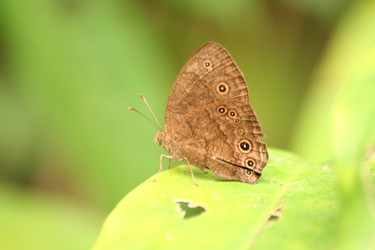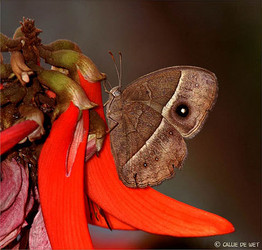Bicyclus
Andrew V. Z. Brower


This tree diagram shows the relationships between several groups of organisms.
The root of the current tree connects the organisms featured in this tree to their containing group and the rest of the Tree of Life. The basal branching point in the tree represents the ancestor of the other groups in the tree. This ancestor diversified over time into several descendent subgroups, which are represented as internal nodes and terminal taxa to the right.

You can click on the root to travel down the Tree of Life all the way to the root of all Life, and you can click on the names of descendent subgroups to travel up the Tree of Life all the way to individual species.
For more information on ToL tree formatting, please see Interpreting the Tree or Classification. To learn more about phylogenetic trees, please visit our Phylogenetic Biology pages.
close boxIntroduction
The bush browns are large endemic African genus. Bicyclus butterflies are noted for marked seasonal polyphenism of wing patterns, especially in the size of the eyespots. The eye spots of Bicyclus anynana is a popular model system for the study of wing pattern development and genetics (cf. Beldade & Brakefield, 2002).
Discussion of Phylogenetic Relationships
The topology is based on the molecular phylogenetic hypothesis of Monteiro & Pierce (2001).
References
Ackery PR, Smith CR, and Vane-Wright RI eds. 1995. Carcasson's African butterflies. Canberra: CSIRO.
Beldade, P & Brakefield PM. 2002. The genetics and evo-devo of butterfly wing patterns. Nature Reviews Genetics 3, 442-452.
Condamin M. 1973. monographie du genre Bicyclus (Lepidoptera: Satyridae). Mém. Inst. Fond. Afrique Noire 88: 1-324.
Larsen, T. B. 2005. Butterflies of West Africa. Apollo Books, Stenstrup, Denmark.
Monteiro A, and Pierce NE. 2001. Phylogeny of Bicyclus (Lepidoptera: Nymphalidae) inferred from COI, COII and Ef-1alpha gene sequences. Mol. Phylogenet. Evol. 18: 264-281.
Title Illustrations

| Scientific Name | Bicyclus sandace |
|---|---|
| Location | Gabon |
| Specimen Condition | Live Specimen |
| Source | Bicyclus sandace |
| Source Collection | Flickr |
| Image Use |
 This media file is licensed under the Creative Commons Attribution License - Version 2.0. This media file is licensed under the Creative Commons Attribution License - Version 2.0.
|
| Copyright | © 2006 Axel Rouvin |
| Scientific Name | Bicyclus safitza |
|---|---|
| Location | Africa |
| Comments | Common Bush Brown Bicyclus safitza safitza , (Hewitson, 1851), Family Satyrinae – Wingspan M 40-43 cm, F 45-48 cm. The flower is from an Erythrina or Coral tree family. This is the most common brown b’fly in Africa & found almost anywhere where forests and thick vegetation occur. The M is dark brown, the F slightly lighter. Both have the eye-spots on the upperside of the forewing, often indistinct and also eye-spots on the underside of the forewing & also sometimes on the hindwing. They fly throughout the year, more in summer than in winter, & summer forms are more distinctly marked than their winter counterparts. Its flight is weak and floppy, and it seldom flies long. It looks like a dead leaf when settled on the leafy foliage of the forest floor. |
| Specimen Condition | Live Specimen |
| Source | COMMON BUSH BROWN |
| Source Collection | Flickr |
| Copyright |
© 2006 Callie de Wet

|
About This Page

Middle Tennessee State University, Murfreesboro, Tennessee, USA
Correspondence regarding this page should be directed to Andrew V. Z. Brower at
Page copyright © 2010
 Page: Tree of Life
Bicyclus .
Authored by
Andrew V. Z. Brower.
The TEXT of this page is licensed under the
Creative Commons Attribution License - Version 3.0. Note that images and other media
featured on this page are each governed by their own license, and they may or may not be available
for reuse. Click on an image or a media link to access the media data window, which provides the
relevant licensing information. For the general terms and conditions of ToL material reuse and
redistribution, please see the Tree of Life Copyright
Policies.
Page: Tree of Life
Bicyclus .
Authored by
Andrew V. Z. Brower.
The TEXT of this page is licensed under the
Creative Commons Attribution License - Version 3.0. Note that images and other media
featured on this page are each governed by their own license, and they may or may not be available
for reuse. Click on an image or a media link to access the media data window, which provides the
relevant licensing information. For the general terms and conditions of ToL material reuse and
redistribution, please see the Tree of Life Copyright
Policies.
- First online 09 November 2006
- Content changed 13 January 2010
Citing this page:
Brower, Andrew V. Z. 2010. Bicyclus . Version 13 January 2010 (under construction). http://tolweb.org/Bicyclus/85314/2010.01.13 in The Tree of Life Web Project, http://tolweb.org/









 Go to quick links
Go to quick search
Go to navigation for this section of the ToL site
Go to detailed links for the ToL site
Go to quick links
Go to quick search
Go to navigation for this section of the ToL site
Go to detailed links for the ToL site